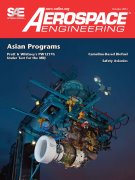Journal Article
Demonstration of a Compact Hydrogen Fuel Cell Power System for UAS Propulsion
2014-09-16
2014-01-2223
We have assembled and demonstrated a prototype power system that uses an innovative hydrogen generator to fuel an ultra-compact PEM fuel cell that is suitable for use in small unmanned aerial system (UAS) propulsion systems. The hydrogen generator uses thermal decomposition of ammonia borane (AB) to produce hydrogen from a very compact and lightweight package. ...The fuel cell plant utilized in the power system prototype has been flown as part of several small UAS development programs and has logged hundreds of hours of flight time. The plant was designed specifically to be readily integrated with a range of hydrogen fueling subsystems and contains the balance of plant necessary to facilitate stand-alone operation.





